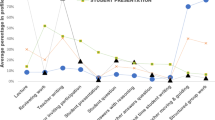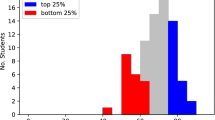Abstract
Predicting which students enrolled in graduate online education are at-risk for failure is an arduous yet important task for teachers and administrators alike. This research reports on a statistical analysis technique using both static and dynamic variables to determine which students are at-risk and when an intervention could be most helpful during a semester. Time-series clustering analysis of online teacher education classes revealed that prediction is possible after the 10th week capturing over 78 % of at-risk students. Visual analysis of dynamic student activities shares a number of striking commonalities consistent with EKG charting. The potential exists for instructors to recognize simple graphic patterns that identify and formatively address these issues with their students. Next phases of research will apply further validation of both the models attempted and additional predictor variables.









Similar content being viewed by others
References
Aman, R. R. (2009). Improving student satisfaction and retention with online instruction through systematic faculty peer review of courses, Unpublished doctoral dissertation, Oregon State University.
Balfanz, R., Herzog, L., & Mac Iver, D. J. (2007). Preventing student disengagement and keeping students on the graduation path in urban middle-grades schools: Early identification and effective interventions. Educational Psychologist, 42(4), 223–235.
Baran, E., & Correia, A. (2014). A professional development framework for online teaching. TechTrends, 58(5), 95–101.
Baran, E., Correia, A., & Thompson, A. (2011). Transforming online teaching practice: Critical analysis of the literature on the roles and competencies of online teachers. Distance Education, 32(3), 421–439.
Cain, M., Phillip, S., Ting, S. R., Gonzalez, L. M., Johnson, J., & Galy, E., et al. (2013). An exploration of students’ experiences of learning in an online primary teacher education program. Journal of Online Learning & Teaching, 9(3).
Chiocchio, F., & Lafrenière, A. (2009). A project management perspective on student’ s declarative commitments to goals established within asynchronous communication. Journal of Computer Assisted learning, 25(3), 294–305.
Cohen, G. L., Garcia, J., Apfel, N., & Master, A. (2006). Reducing the racial achievement gap: A social-psychological intervention. Science, 313(5791), 1307–1310.
Cohen, G. L., Garcia, J., Purdie-Vaughns, V., Apfel, N., & Brzustoski, P. (2009). Recursive processes in self-affirmation: Intervening to close the minority achievement gap. Science, 324(5925), 400–403.
Cole, B., Matheson, K., & Anisman, H. (2007). The moderating role of ethnic identity and social support on relations between well-being and academic performance1. Journal of Applied Social Psychology, 37(3), 592–615.
Crawford-Ferre, H. G., & Wiest, L. R. (2012). Effective online instruction in higher education. The Quarterly Review of Distance Education, 13(1), 11–14.
Dray, B. J., Lowenthal, P. R., Miszkiewicz, M. J., Ruiz-Primo, M. A., & Marczynski, K. (2011). Developing an instrument to assess student readiness for online learning: A validation study. Distance Education, 32(1), 29–47.
Falloon, G. (2011). Making the connection: Moore’s theory of transactional distance and its relevance to the use of a virtual classroom in postgraduate online teacher education. Journal of Research on Technology in Education, 43(3), 187–209.
Frankola, K. (2001). Why Online Learners Drop Out. Workforce, 80(10), 53.
Glezakos, T. J., Tsiligiridis, T. A., & Yialouris, C. P. (2014). Piecewise evolutionary segmentation for feature extraction in time series models. Neural Computing and Applications, 24(2), 243–257.
Harrell, I. L. (2008). Increasing the success of online students. Inquiry, 13(1), 36–44.
Hart, C. (2012). Factors associated with student persistence in an online program of study: A review of the literature. Journal of Interactive Online Learning, 11(1), 19–42.
Herbert, M. (2007). Staying the course: A study in online student satisfaction and retention. Online Journal of Distance Learning Administration, 10, 1.
Heyman, E. (2010). Overcoming student retention issues in higher education onlineprograms. Online Journal of Distance Learning Administration, 8, 4.
Ishitani, T. T. (2008). How to explore timing of intervention for students at risk of departure. New Directions for Institutional Research, 2008(137), 105–122.
Kayongo-Male, D., & Lee, M. B. (2004). Macro and micro factors in ethnic identity construction and educational outcomes: Minority university students in the People’s Republic of China. Race Ethnicity and Education, 7(3), 277–305.
Lee, Y., & Choi, J. (2011). A review of online course dropout research: Implications for practice and future research. Educational Technology Research and Development, 59(5), 593–618.
Liu, S., Yamada, M., Collier, N., & Sugiyama, M. (2013). Change-point detection in time-series data by relative density-ratio estimation. Neural Networks, 43, 72–83.
Macfadyen, L. P., & Dawson, S. (2010). Mining LMS data to develop an “early warning system” for educators: A proof of concept. Computers & Education, 54(2), 588–599.
Mazzolini, M., & Maddison, S. (2003). Sage, guide or ghost? The effect of instructor intervention on student participation in online discussion forums. Computers & Education, 40(3), 237–253.
Pan, W., Guo, S., Alikonis, C., & Bai, H. (2008). Do intervention programs assist students to succeed in college? A multilevel longitudinal study. College Student Journal, 42(1), 90–98.
Patterson, B., & McFadden, C. (2009). Attrition in online and campus degree programs. Online Journal of Distance Learning Administration, 12, 2.
Perry, B., Boman, J., Care, W. D., Edwards, M., & Park, C. (2008). Why do students withdraw from online graduate nursing and health studies education? Journal of Educators Online, 5(1), n1.
Pullan, M. (2013). Using robotics to improve retention and increase comprehension in introductory programming courses. Journal of Educational Technology Systems, 42(2), 141–150.
Terrell, S. R., Snyder, M. M., & Dringus, L. P. (2009). The development, validation, and application of the Doctoral Student Connectedness Scale. The Internet and Higher Education, 12(2), 112–116.
Webb, E., Jones, A., Barker, P., & van Schaik, P. (2004). Using e-learning dialogues in higher education. Innovations in Education and Teaching International, 41(1), 93–103.
Winerman, L. (2012). Reading, writing, and self-esteem. Utne Reader: The Best Of The Alternative Press, 169, 16–17.
Author information
Authors and Affiliations
Corresponding author
Rights and permissions
About this article
Cite this article
Shelton, B.E., Hung, JL. & Baughman, S. Online Graduate Teacher Education: Establishing an EKG for Student Success Intervention. Tech Know Learn 21, 21–32 (2016). https://doi.org/10.1007/s10758-015-9254-8
Published:
Issue Date:
DOI: https://doi.org/10.1007/s10758-015-9254-8




